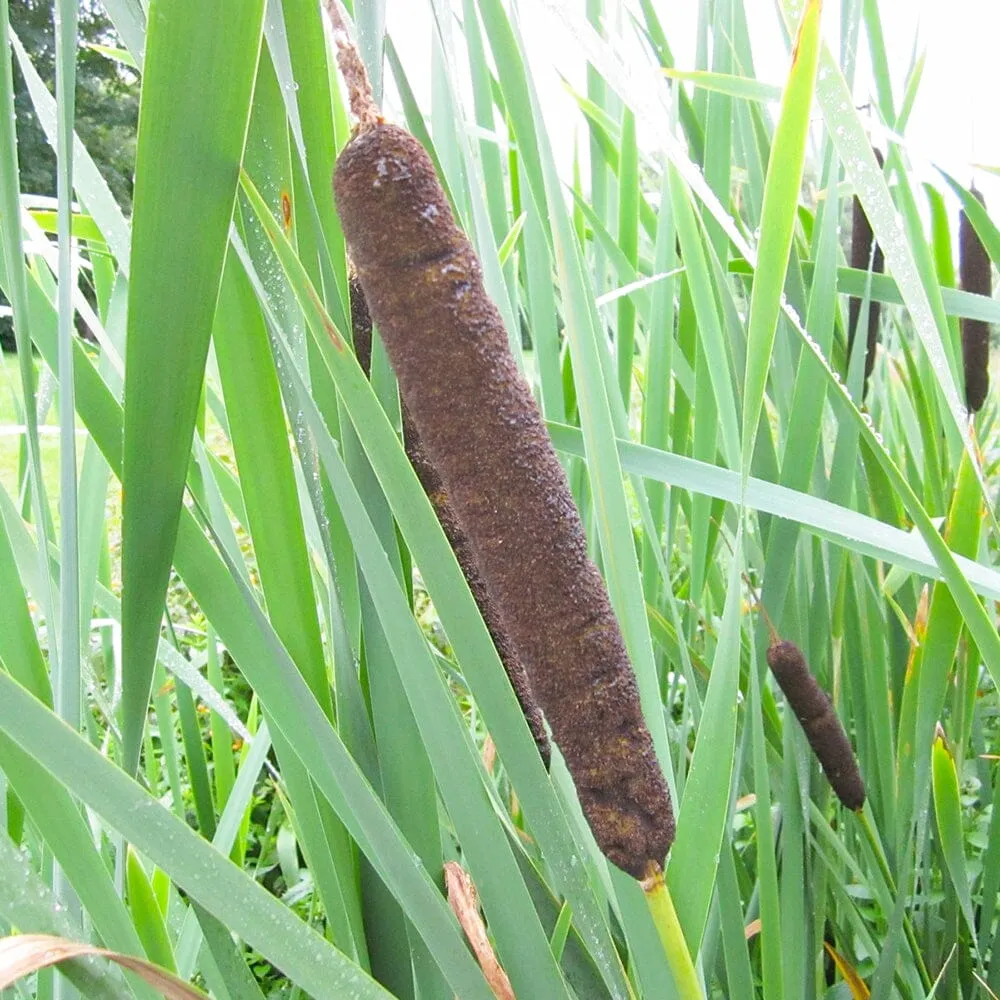Typha latifolia, commonly known as Broadleaf Cattail or Common Cattail, is a perennial aquatic plant belonging to the Typhaceae family. It is native to wetland habitats and is characterized by its tall, upright growth and distinctive brown, cylindrical flower spikes. Here's a detailed description and care guide for Typha latifolia:
Description:
Typha latifolia forms large clumps of erect stems that can reach heights of 3-10 feet (1-3 meters). The stems are stout, rigid, and unbranched, with long, flat, strap-like leaves that grow along the length of the stem. The leaves are typically green and have a parallel arrangement. The plant produces unique flower spikes that emerge from the top of the stems. The flower spikes are cylindrical in shape and covered with tiny, brownish florets. The male and female flowers are separated on the spikes, with the male flowers located at the top and the female flowers located below. After pollination, the female flowers develop into cylindrical seed heads that are covered in downy, cotton-like fibers. These seed heads persist through winter and disperse the seeds in the following spring.
Care Guide:
Water: Typha latifolia is an aquatic plant that thrives in consistently moist or shallow water. It prefers still or slow-moving water, such as ponds, marshes, and the edges of lakes and streams. Ensure that the water level is kept consistent and does not dry out completely. If grown in containers, ensure that the pots are submerged in water or placed in a tray with standing water.
Lighting: This plant prefers full sun to partial shade. It can tolerate some shade, but it generally performs best in bright light conditions. Adequate sunlight is important for promoting healthy growth and flowering. In hot climates, some afternoon shade may be beneficial to protect the plant from intense heat.
Soil: Typha latifolia is adaptable to a variety of soil types, including clay, loam, or sandy soils. However, it prefers rich, organic soil that retains moisture well. If growing in containers, use a heavy, loamy soil mixed with aquatic planting media to provide adequate nutrients and moisture retention.
Temperature: This plant is hardy in USDA hardiness zones 3-9. It is adapted to a wide range of temperatures and can tolerate both cold and warm climates. It is relatively resilient and can withstand temperature fluctuations. However, extreme heat or severe frost may cause some damage to the plant.
Maintenance: Typha latifolia is a low-maintenance plant. Remove any dead or yellowed leaves or spent flower spikes to maintain a neat appearance. As the plant can spread through rhizomes, it may require periodic division to prevent overcrowding. Dividing the clumps every few years also helps rejuvenate the plant and promote healthier growth.
Wildlife Value: Typha latifolia provides valuable habitat and food sources for various wildlife. Its dense clumps provide nesting sites and cover for birds, while the seed heads and foliage offer food and shelter for birds, insects, and small mammals. The plant also plays a role in stabilizing soil and preventing erosion in wetland habitats.
Typha latifolia is a striking and valuable plant for water gardens, ponds, and wetland restoration projects. Its tall, upright growth and distinctive flower spikes make it a prominent feature. By following these care guidelines, you can successfully grow Typha latifolia and enjoy its beauty and ecological benefits in your landscape.













![Minn Kota Terrova QUEST 90/115 Trolling Motor w/Wireless Remote - Dual Spectrum CHIRP - 24/36V - 90/115LBS - 72" [1358202] Minn Kota Terrova QUEST 90/115 Trolling Motor w/Wireless Remote - Dual Spectrum CHIRP - 24/36V - 90/115LBS - 72" [1358202]](https://www.summlx.shop/image/minn-kota-terrova-quest-90115-trolling-motor-wwireless-remote-dual-spectrum-chirp-2436v-90115lbs-72quot-1358202_QTT1Cg_300x.webp)

